|
If a weight has a figure inside, animal or plant, it is almost
certainly the result of lampworking where the figure is built up then encased in
clear glass. Flower blossoms can be made at the furnace, especially
roses and lilies. Millefiori weights are made at the furnace, the cane first
then encased (below),
although some canes have details best made at the torch. Furnace weights
are most often built up of abstract color, twisted or pushed, perhaps with
bubbles. Josh Simpson's world weights and Devil's Fire weights are the
best known examples.
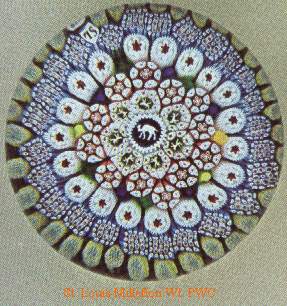 This paperweight is a classic millefiori (thousand
flowers) weight with murrini images, including a camel in the
center and a year cane near the top. The uniform spaces between
canes are created by a clear glass outer layer on the cane that
merges with the cover glass. Depending on the thickness of that
layer, the cane will look more or less solid. The layer of cane
does not cover the full diameter of the weight as it appears in
this top view, which enlarges the decorations due to the lens
effect of the classic domed weight. This paperweight is a classic millefiori (thousand
flowers) weight with murrini images, including a camel in the
center and a year cane near the top. The uniform spaces between
canes are created by a clear glass outer layer on the cane that
merges with the cover glass. Depending on the thickness of that
layer, the cane will look more or less solid. The layer of cane
does not cover the full diameter of the weight as it appears in
this top view, which enlarges the decorations due to the lens
effect of the classic domed weight.
This kind of weight is made by building the cane first,
cutting the millefiori slices from the cane, and aligning them in
a holder, upside down. After heating, a gather of molten glass is
brought to the back to pickup all the millefiori and then further
glass is gathered over. See below.
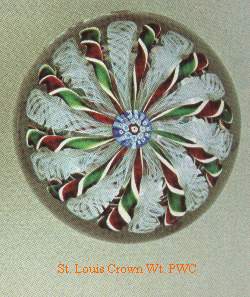 This crown style weight is made by preparing
latticino cane (white threads around a clear core) and twisted
candy cane (a flat ribbon with red on one side and green on the
other and white along the edges, cased in clear and twisted)
these being softened and laid around a clear core (or made into a
long rod which is then pinched off for the section in this weight.)
A small millefiori cane accents the middle and hides the junction. This crown style weight is made by preparing
latticino cane (white threads around a clear core) and twisted
candy cane (a flat ribbon with red on one side and green on the
other and white along the edges, cased in clear and twisted)
these being softened and laid around a clear core (or made into a
long rod which is then pinched off for the section in this weight.)
A small millefiori cane accents the middle and hides the junction.
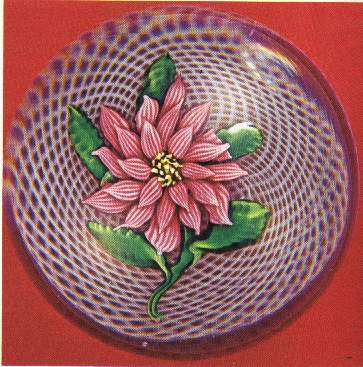 The flower is lampworked detail, being made up at a
torch. The petals were made from white and red striped cane,
pulled to a taper. After the flower was made, the leaves were
probably made separately and both laid for pickup. In a modern
shop, a vacuum cup would insure the glass encased the flower
without bubbles. The spiral lines are a latticino cane (or could
be engraved lines on the clear bottom.) The flower is lampworked detail, being made up at a
torch. The petals were made from white and red striped cane,
pulled to a taper. After the flower was made, the leaves were
probably made separately and both laid for pickup. In a modern
shop, a vacuum cup would insure the glass encased the flower
without bubbles. The spiral lines are a latticino cane (or could
be engraved lines on the clear bottom.)
Lampworked detail can be very great, building complete plants
and/or animals. Paul Stankard (next) is the best at this, telling
small stories in the creatures that occupy the roots and stems of
the botanicals he creates.
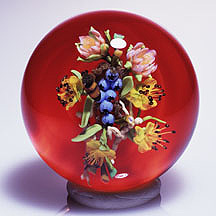 Paul Stankard
produces stunning paperweights, many of which are rectangular,
made by grinding and polishing the glass after it is cold. Many
are assembled (glued) with other materials acting as separators.
Paul is primarily a lampworker, making the innards and then
encasing them. His small weights, like the one at right sell in
the thousands; his rectangular ones in the 10's of thousands. To
see some of each, click here
or on the image. Paul Stankard
produces stunning paperweights, many of which are rectangular,
made by grinding and polishing the glass after it is cold. Many
are assembled (glued) with other materials acting as separators.
Paul is primarily a lampworker, making the innards and then
encasing them. His small weights, like the one at right sell in
the thousands; his rectangular ones in the 10's of thousands. To
see some of each, click here
or on the image.
 This is a modern weight
from Lundberg Studios. A Google search returns over 1100 hits on
Lundberg most of which have at least one very good image of a
weight, often with side view, here is one
and another. This
weight has lampworked hearts, what are probably small sulphide
stars and a ground with a drawn decoration. Lundberg pioneered
the modern lampworked weight and related vessels encasing detailed
lampworked pieces in the glass. This is a modern weight
from Lundberg Studios. A Google search returns over 1100 hits on
Lundberg most of which have at least one very good image of a
weight, often with side view, here is one
and another. This
weight has lampworked hearts, what are probably small sulphide
stars and a ground with a drawn decoration. Lundberg pioneered
the modern lampworked weight and related vessels encasing detailed
lampworked pieces in the glass.
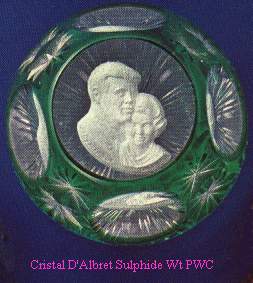 This modern weight illustrates three techniques not
shown in previous examples. The image of the Kennedy's is a
sulphide which is basically made of a mixture of glass
ingredients plus clay or silica that is molded and fired. Tiny
bubbles formed during encasement give the surface a silvery white
sheen. This weight was also cased with transparent green which
was cut away to form the round windows. Further, the base and
spaces between the windows were cut (engraved) in a star pattern
to form the background. The amount of hand coldworking in this
weight is very high. This modern weight illustrates three techniques not
shown in previous examples. The image of the Kennedy's is a
sulphide which is basically made of a mixture of glass
ingredients plus clay or silica that is molded and fired. Tiny
bubbles formed during encasement give the surface a silvery white
sheen. This weight was also cased with transparent green which
was cut away to form the round windows. Further, the base and
spaces between the windows were cut (engraved) in a star pattern
to form the background. The amount of hand coldworking in this
weight is very high.
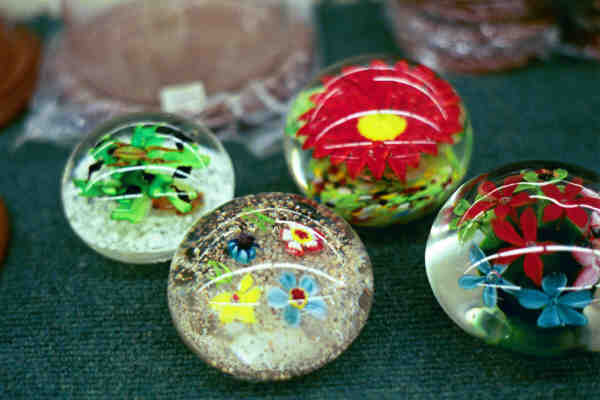 These are foreign made
paperweights sold at Elliott's Hardware for the prices shown in
the last picture. At first glance they seem very nice. The glass
is clear and free of bubbles. The red one is perhaps the best.
Closer examination reveals the speed with which they were made
and the flaws. For example, the yellow flower in the picture to
the right is missing a petal. These are foreign made
paperweights sold at Elliott's Hardware for the prices shown in
the last picture. At first glance they seem very nice. The glass
is clear and free of bubbles. The red one is perhaps the best.
Closer examination reveals the speed with which they were made
and the flaws. For example, the yellow flower in the picture to
the right is missing a petal.
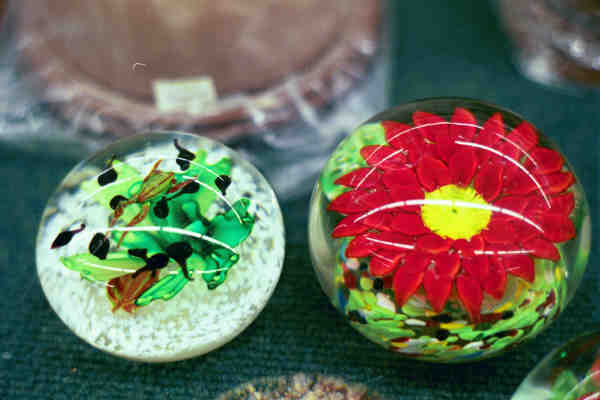 While the red flower is
rather good, a look at the tadpole piece shows that some are
missing their tails and at least one tail is a fragment free in
the piece. While the red flower is
rather good, a look at the tadpole piece shows that some are
missing their tails and at least one tail is a fragment free in
the piece.
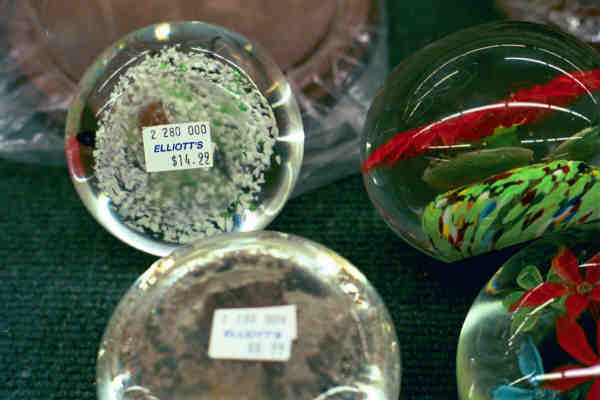 These
prices are astounding to me. Cut this price about in half to get
the wholesale cost, subtract shipping expenses and these things
are being put out for a factory price of $5-6. These
prices are astounding to me. Cut this price about in half to get
the wholesale cost, subtract shipping expenses and these things
are being put out for a factory price of $5-6.
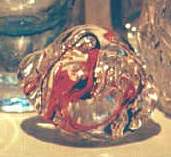 This
weight (my own) is an example of a twisted core weight, without a
smooth surface in this case. To make this weight, color fragments
were picked up on a hot punty and after heating were twisted to
form a miscellaneous shape using jacks. The shape was pierced so
that bubbles were formed when a further gather of clear glass was
taken. This weight was "air marvered" that is, it was
turned on the punty, controlling the drip flow, until set. This
results in unusual shapes that often produce brilliantly clear
weights. Many of my weights are made to sit at an angle for
viewing on a table rather than sitting the traditional flat
position. This
weight (my own) is an example of a twisted core weight, without a
smooth surface in this case. To make this weight, color fragments
were picked up on a hot punty and after heating were twisted to
form a miscellaneous shape using jacks. The shape was pierced so
that bubbles were formed when a further gather of clear glass was
taken. This weight was "air marvered" that is, it was
turned on the punty, controlling the drip flow, until set. This
results in unusual shapes that often produce brilliantly clear
weights. Many of my weights are made to sit at an angle for
viewing on a table rather than sitting the traditional flat
position.
Making a Weight
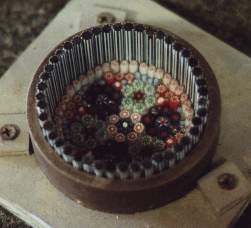 This
is a setup for a millefiori weight. Inside a steel ring on a heat
proof base, the prepared cane pieces are set in place. The is the
back of the base we are looking at. After heating with a torch (here)
or on a hot plate (with a metal base), a gather of glass is
brought to be placed in the middle. Some workers use a pipe to
bring the gather and provide a bigger working head. The longer
canes will form the sides of the base. After pickup and initial
smoothing and shaping, the clear dome will be gathered on the
other side (bottom in this picture) and final dome shaping takes
place. Drew Ebelhare makes a paperweight This
is a setup for a millefiori weight. Inside a steel ring on a heat
proof base, the prepared cane pieces are set in place. The is the
back of the base we are looking at. After heating with a torch (here)
or on a hot plate (with a metal base), a gather of glass is
brought to be placed in the middle. Some workers use a pipe to
bring the gather and provide a bigger working head. The longer
canes will form the sides of the base. After pickup and initial
smoothing and shaping, the clear dome will be gathered on the
other side (bottom in this picture) and final dome shaping takes
place. Drew Ebelhare makes a paperweight
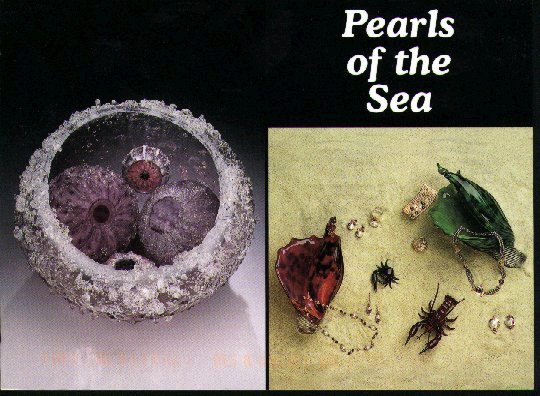 The weight to
the left on this post card advertising a show at Carlyn Galerie,
Dallas, is a crusted shell on the outside so that the inside
cannot be seen except that one side has been ground flat and
polished. Inside we see images of sea life against a reef-like
background. I am sorry, but at this writing, I don't know the
creator. Similar results have shown a cave-like image from Fire
Island in Austin. The weight to
the left on this post card advertising a show at Carlyn Galerie,
Dallas, is a crusted shell on the outside so that the inside
cannot be seen except that one side has been ground flat and
polished. Inside we see images of sea life against a reef-like
background. I am sorry, but at this writing, I don't know the
creator. Similar results have shown a cave-like image from Fire
Island in Austin.
|
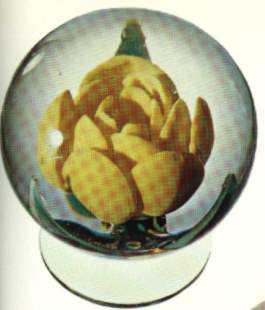



 The flower is lampworked detail, being made up at a
torch. The petals were made from white and red striped cane,
pulled to a taper. After the flower was made, the leaves were
probably made separately and both laid for pickup. In a modern
shop, a vacuum cup would insure the glass encased the flower
without bubbles. The spiral lines are a latticino cane (or could
be engraved lines on the clear bottom.)
The flower is lampworked detail, being made up at a
torch. The petals were made from white and red striped cane,
pulled to a taper. After the flower was made, the leaves were
probably made separately and both laid for pickup. In a modern
shop, a vacuum cup would insure the glass encased the flower
without bubbles. The spiral lines are a latticino cane (or could
be engraved lines on the clear bottom.)

 This modern weight illustrates three techniques not
shown in previous examples. The image of the Kennedy's is a
sulphide which is basically made of a mixture of glass
ingredients plus clay or silica that is molded and fired. Tiny
bubbles formed during encasement give the surface a silvery white
sheen. This weight was also cased with transparent green which
was cut away to form the round windows. Further, the base and
spaces between the windows were cut (engraved) in a star pattern
to form the background. The amount of hand coldworking in this
weight is very high.
This modern weight illustrates three techniques not
shown in previous examples. The image of the Kennedy's is a
sulphide which is basically made of a mixture of glass
ingredients plus clay or silica that is molded and fired. Tiny
bubbles formed during encasement give the surface a silvery white
sheen. This weight was also cased with transparent green which
was cut away to form the round windows. Further, the base and
spaces between the windows were cut (engraved) in a star pattern
to form the background. The amount of hand coldworking in this
weight is very high. 




